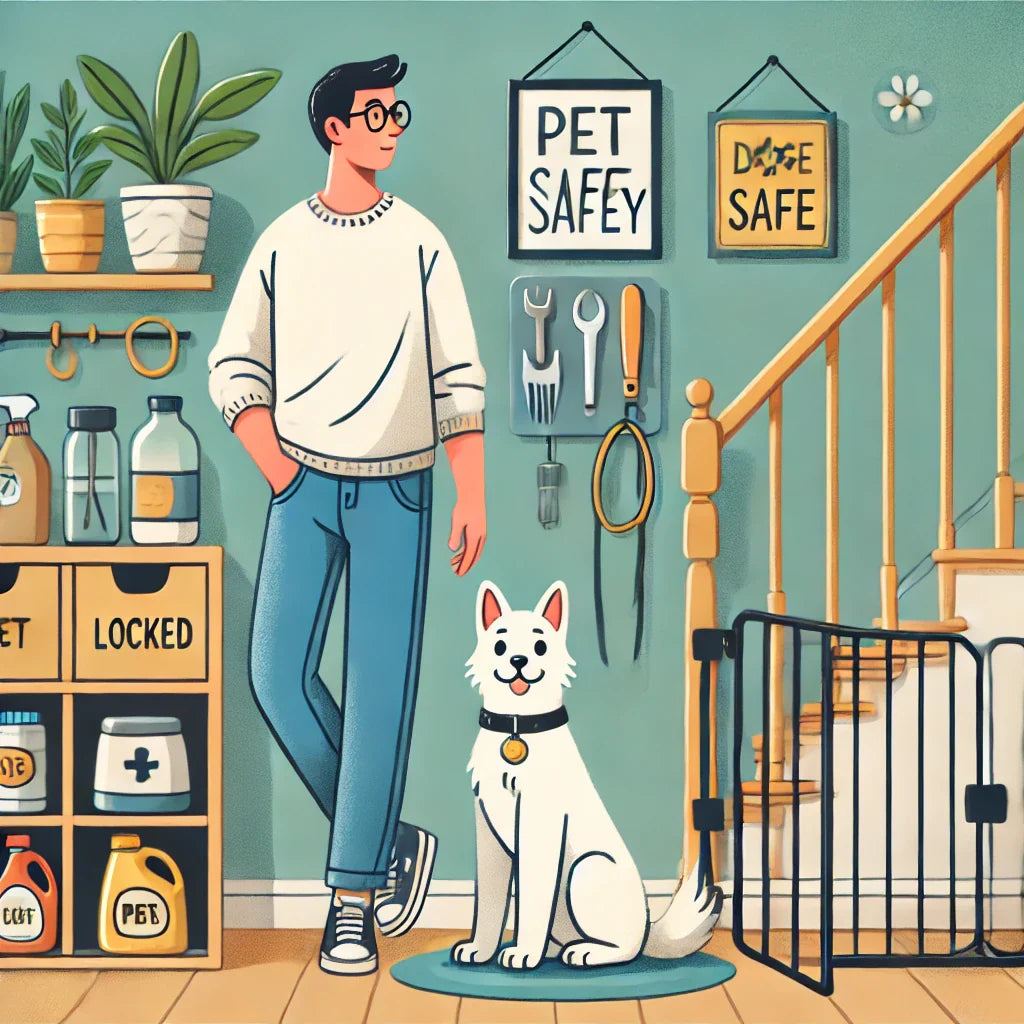
Pet Safety at Home: A Complete Guide to Preventing Household Hazards
Share

Introduction: Why Pet Safety at Home is Essential
Your home is your pet’s sanctuary, but hidden household hazards can pose serious risks to their well-being. From toxic substances to electrical cords, and fall risks, understanding potential dangers is crucial in ensuring a safe home environment for pets.
What You’ll Learn in This Guide:
✔ Room-by-room pet-proofing tips
✔ Common household hazards and how to prevent them
✔ Emergency preparedness strategies for pets
✔ How to make your home a pet-friendly space
1. Room-by-Room Pet-Proofing Guide
📌 How Can You Pet-Proof Every Area of Your Home?
🚪 Living Room:
✔ Secure loose wires and electrical cords—use protective covers.
✔ Choose non-toxic plants—many common houseplants are toxic to pets.
✔ Keep small objects and choking hazards out of reach.
🍽 Kitchen:
✔ Store toxic foods like chocolate, onions, and grapes away from pets.
✔ Keep cleaning products locked away in cabinets.
✔ Prevent access to hot stoves or sharp utensils.
🛁 Bathroom & Laundry:
✔ Keep medications and chemicals out of reach.
✔ Close toilet lids to prevent accidental drinking or drowning.
✔ Store detergents and soaps in sealed containers.
🛏 Bedrooms & Play Areas:
✔ Secure small objects, jewelry, and plastic items.
✔ Avoid hanging cords from blinds or curtains, which can cause strangulation.
✔ Use pet-proof storage bins for toys and accessories.
🚗 Garage & Outdoor Spaces:
✔ Store antifreeze and chemicals high up—even small amounts can be fatal.
✔ Avoid leaving tools, sharp objects, or car parts exposed.
✔ Ensure fences and gates are secure to prevent escapes.
🐾 Ensure your home is a safe space for your pet—a well-prepared home reduces the risk of accidents.
2. Identifying and Preventing Common Household Hazards
📌 What Are the Most Common Household Dangers for Pets?
🚨 Toxic Substances:
✔ Human medications (painkillers, antidepressants, and cold medicine).
✔ Household cleaners and detergents—opt for pet-safe cleaning products.
✔ Certain essential oils and air fresheners—many are toxic to cats and dogs.
🚨 Choking & Ingestion Hazards:
✔ Small objects like buttons, batteries, and rubber bands.
✔ Plastic bags or packaging materials—can cause suffocation.
✔ Cooked bones—they splinter easily and can cause internal damage.
🚨 Fall & Injury Risks:
✔ Open windows—use pet-proof screens to prevent falls.
✔ Slippery floors—add rugs or pet-friendly mats for better grip.
✔ Baby gates for pet safety—use them to restrict access to staircases.
🐾 Reduce the risk of injuries with these preventive measures—taking precautions prevents serious pet emergencies.
3. Securing Your Home Against Toxic Substances
📌 How Can You Keep Pets Safe from Toxic Items?
✔ Store chemicals, medications, and household cleaners in pet-proof cabinets.
✔ Keep all food items away—many human foods are dangerous to pets.
✔ Choose pet-safe alternatives for cleaning products and plants.
✔ Ensure trash cans have secure lids to prevent pets from rummaging.
🐾 Be ready for emergencies with this life-saving guide—preparing for accidents ensures quicker response time.
4. Preventing Electrical and Fire Hazards for Pets
📌 How Can You Protect Pets from Electrical Dangers?
✔ Secure loose electrical cords—use chew-proof covers or hide them.
✔ Unplug unused appliances to prevent accidents.
✔ Install smoke and carbon monoxide detectors in pet-accessible areas.
✔ Use pet-safe space heaters—avoid ones that can easily tip over.
5. Emergency Preparedness: Protecting Pets from Unexpected Risks
📌 How to Prepare for Pet Emergencies at Home?
🚨 Step 1: Create a Pet Emergency Kit
✔ Pet first-aid supplies (bandages, antiseptic, gloves).
✔ Copies of pet medical records and emergency vet contacts.
✔ Pet-friendly food, water, and medication for at least 72 hours.
✔ Leash, carrier, and comfort items (blanket, toys).
🚨 Step 2: Have a Fire & Evacuation Plan
✔ Label doors and windows with pet rescue stickers.
✔ Ensure pets are microchipped and have ID tags.
✔ Designate a pet-friendly emergency meeting spot.
🚨 Step 3: Practice Emergency Drills
✔ Train pets to respond to recall commands.
✔ Teach them to enter carriers or crates quickly in emergencies.
✔ Familiarize pets with calm, low-stress evacuation routines.
🐾 Be ready for emergencies with this life-saving guide—preparation can mean the difference between life and death.
6. Creating a Safe and Comfortable Environment for Pets
📌 How to Make Your Home Pet-Friendly?
✔ Provide designated safe zones where pets can rest without stress.
✔ Use calming aids—pheromone diffusers, cozy beds, and hideaway spaces.
✔ Regularly inspect fences, pet doors, and enclosures for safety.
✔ Establish a routine with exercise and mental stimulation to prevent anxiety.
🐾 Consider pet insurance to cover unexpected medical expenses—having coverage can ease financial stress during emergencies.
